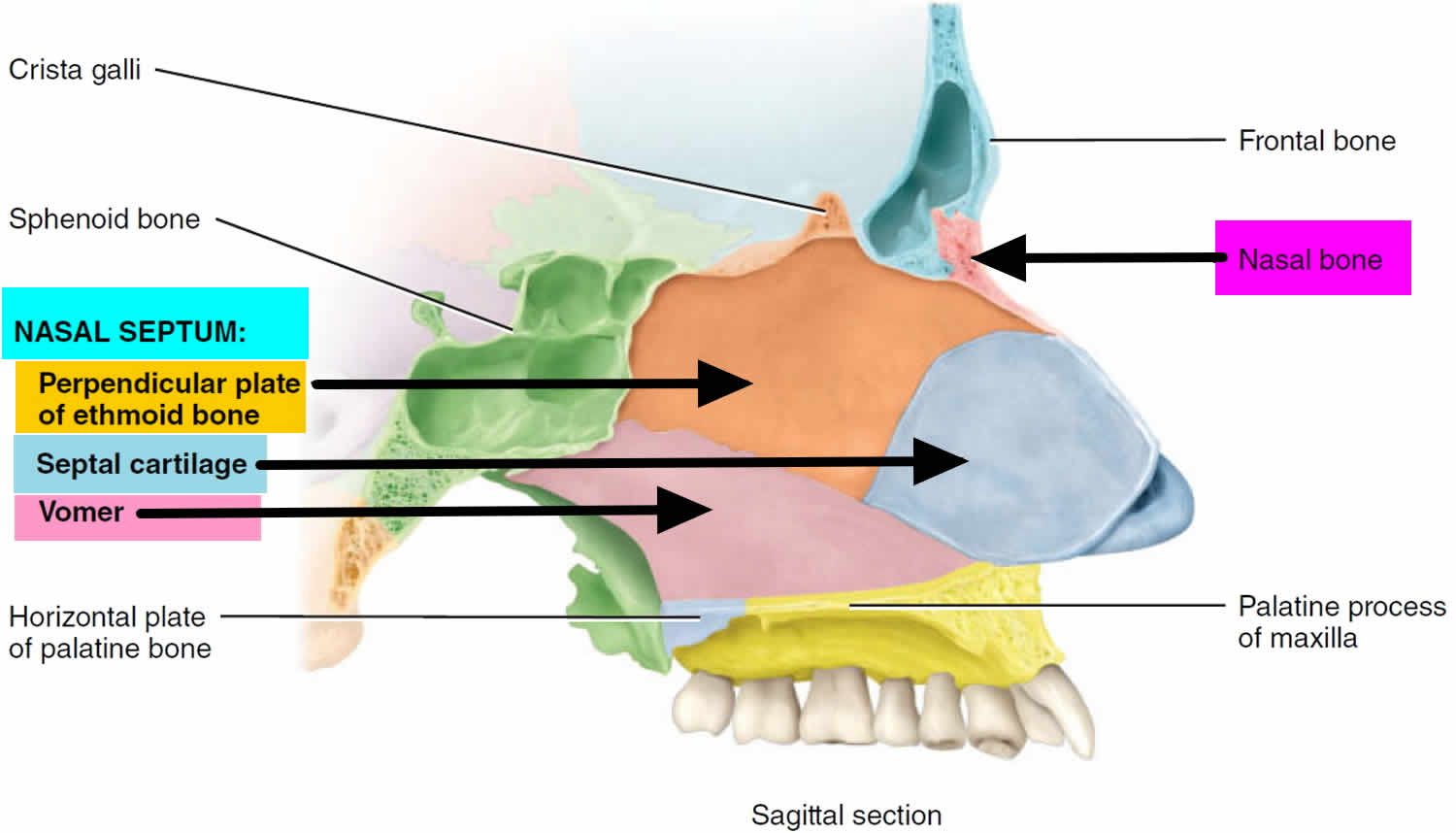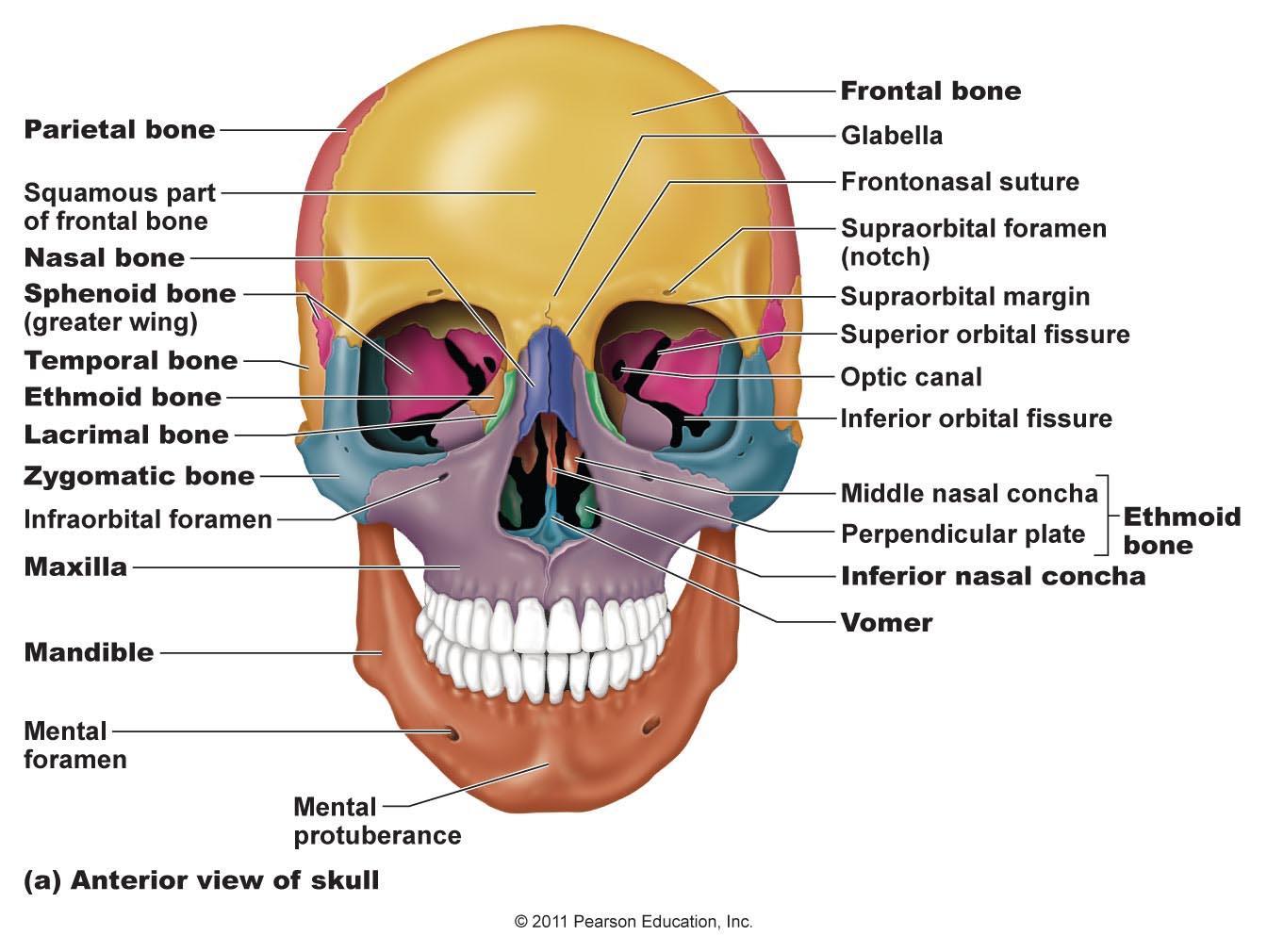Which Bones Form The Nasal Septum
Which Bones Form The Nasal Septum - It makes up the facial skeleton ( viscerocranium) along with the zygomatic bone, maxillae, palatine bones, lacrimal bones, inferior nasal conchae, vomer and mandible. It is made up of the septal cartilage, the vomer bone , and the perpendicular plate of the ethmoid bone. Web [3] the roof of each nasal cavity is formed in its upper third to one half by the nasal bone and more inferiorly by the junctions of the upper lateral cartilage and nasal septum. The lowest part of the septum is a narrow strip of bone that projects from the maxilla. The roof of a building. The nasal septum is made up of cartilage and bone. The nasal septum is composed of five structures: Where the maxilla and lacrimal bones connect, the lacrimal groove is formed. Each rectangular bone has an internal and external surface and four borders. The bones contributing to the formation of the nasal septum can be classified as paired or unpaired.
Perpendicular plate of ethmoid bone, vomer bone, cartilage of the septum, crest of the maxillary bone, and crest of the palatine bone. When looking into the nasal cavity from the front of the skull, two bony plates are seen projecting from each lateral wall. The nasal bone is located medial to the frontal processes of the maxillae. The nasal septum is composed of five structures: Web gross anatomy the vertical midline nasal septum is comprised primarily of a single nasal cartilage from the external nose and two bones. Ethmoid and vomer which bone of the axial skeleton does not have a direct connection to any other bone? Web the nasal bones form the roof, while the frontal process of the maxilla and lacrimal bone forms the sides of the nose. Departure of the nasal septum from the center line of the nose. It runs down the center of your nose and separates the two nasal cavities. Web the nasal septum is the wall in the middle of the nasal respiratory cavity.
The nasal septum is composed of five structures: The perpendicular plate of the ethmoid, the vomer (one discrete septal bone), both of which are tucked underneath the nasal bones. Web the bones that contribute to the nasal septum can be divided into: The bones of your nose are known as the nasal septum. Web the nasal septum is composed of bones and cartilage covered with a mucous membrane called squamous epithelium. Each rectangular bone has an internal and external surface and four borders. Web the nasal bone is a paired flat bone located at the upper third of the nose bridge. The anterior portion of the nasal septum is made of irregular quadrangular hyaline cartilage that inserts into the nasomaxillary crest of the maxilla and nasal spine 2). Nasal, maxillary, and palatine bones. Web gross anatomy the vertical midline nasal septum is comprised primarily of a single nasal cartilage from the external nose and two bones.
Nasal Cavity Definition, Anatomy, Functions, Diagrams
Is nasal septum a bone? Each side of the nasal cavity is triangular in shape, with a broad inferior space that narrows superiorly. The perpendicular plate of the ethmoid, the vomer (one discrete septal bone), both of which are tucked underneath the nasal bones. The nasal septum is made up of cartilage and bone. Web the upper portion of the.
Nasal septum anatomy, function, nasal septum deviation & hole
The nose is divided into two sides by the septum. It runs down the center of your nose and separates the two nasal cavities. Web gross anatomy the vertical midline nasal septum is comprised primarily of a single nasal cartilage from the external nose and two bones. The roof of a building. Each side of the nasal cavity is triangular.
Pin on Learn Anatomy
Each rectangular bone has an internal and external surface and four borders. Is nasal septum a bone? The nasal septum is made up of cartilage and bone. Perpendicular plate of ethmoid bone. Web which bones make up the nasal septum, which divides the left nostril from the right?
Vomer Bone In Nose The primary bone in the septum of the nose is
The nasal septum is composed of five structures: The nasal bone is located medial to the frontal processes of the maxillae. The perpendicular plate of the ethmoid, the vomer (one discrete septal bone), both of which are tucked underneath the nasal bones. Maxillary bone (the crest) perpendicular plate of ethmoid bone; Web the fleshy external end of the nasal septum.
Nasal Cavity arterial supply and nasal meatuses and chonchae
Web the nasal septum is composed of bones and cartilage covered with a mucous membrane called squamous epithelium. Nasal, maxillary and palatine bones unpaired bones: Web whilst the vomer, maxillary and palatine bones form the inferior part of the nasal septum 1). Web the bones that contribute to the nasal septum can be divided into: Web os nasale 1/7 synonyms:
Bones Forming Nasal Cavity Medial Wall Of The Nasal Cavity Anatomy
Web the fleshy external end of the nasal septum is sometimes also called columella. The nasal septum contains bone and hyaline cartilage. Anteriorly the septal cartilage (quadrangular cartilage) approximates a quadrilateral shape. Where the maxilla and lacrimal bones connect, the lacrimal groove is formed. The bones contributing to the formation of the nasal septum can be classified as paired or.
Deviated Septum Causes, Symptoms, How To Fix A Deviated Septum
Perpendicular plate of ethmoid bone. The roof of a building. Perpendicular plate of ethmoid bone, vomer bone, cartilage of the septum, crest of the maxillary bone, and crest of the palatine bone. Web [3] the roof of each nasal cavity is formed in its upper third to one half by the nasal bone and more inferiorly by the junctions of.
Deviated Septum Causes, Symptoms, How To Fix A Deviated Septum
The nasal bone is located medial to the frontal processes of the maxillae. Web the nasal bones form the roof, while the frontal process of the maxilla and lacrimal bone forms the sides of the nose. This groove is where the lacrimal sac resides. The bones contributing to the formation of the nasal septum can be classified as paired or.
nasal complex bones Google Search Nasal septum, Nasal cavity
Web the nasal bones form the roof, while the frontal process of the maxilla and lacrimal bone forms the sides of the nose. The perpendicular plate of the ethmoid, the vomer (one discrete septal bone), both of which are tucked underneath the nasal bones. Web the posterior portion of the septum is made up of several different bones; The septum.
Anatomy of nasal septum. Download Scientific Diagram
Crest of the palatine bone. It makes up the facial skeleton ( viscerocranium) along with the zygomatic bone, maxillae, palatine bones, lacrimal bones, inferior nasal conchae, vomer and mandible. These bones also feature holes (foramina) that allow veins to pass through from the skin. The paired bones are the: Web the upper portion of the nasal septum is formed by.
Web The Nasal Septum Is In The Midline Of The Nose And Made Of Flat Cartilage Anteriorly And Bone Posteriorly.
The nasal septum is composed of five structures: The perpendicular plate of the ethmoid, the vomer (one discrete septal bone), both of which are tucked underneath the nasal bones. Web which bones make up the nasal septum, which divides the left nostril from the right? Web how many bones are in the nasal septum?
Posteriorly It Meets The Concave Anterior Margins Of The Ethmoid And Vomer.
The lacrimal sac is important in the tear production process. For others, a nose injury causes it. The nose is divided into two sides by the septum. Departure of the nasal septum from the center line of the nose.
None The Nasal Bone Is A Small, Flat Bone Of The Skull.
Surgery can repair a deviated septum. Web the external part of the nose consists of a root (superiorly), apex (inferiorly), dorsum, nares. Perpendicular plate of ethmoid bone. Each rectangular bone has an internal and external surface and four borders.
The Nasal Septum Is Made Up Of Cartilage And Bone.
The ethmoid and vomer bones are unpaired. The bones contributing to the formation of the nasal septum can be classified as paired or unpaired. Web the bones that contribute to the nasal septum can be divided into: Connective tissue and skin cover the bony and cartilaginous components of the.









